steering SAAB 9-5 2003 Owners Manual
[x] Cancel search | Manufacturer: SAAB, Model Year: 2003, Model line: 9-5, Model: SAAB 9-5 2003Pages: 288, PDF Size: 16.78 MB
Page 3 of 288
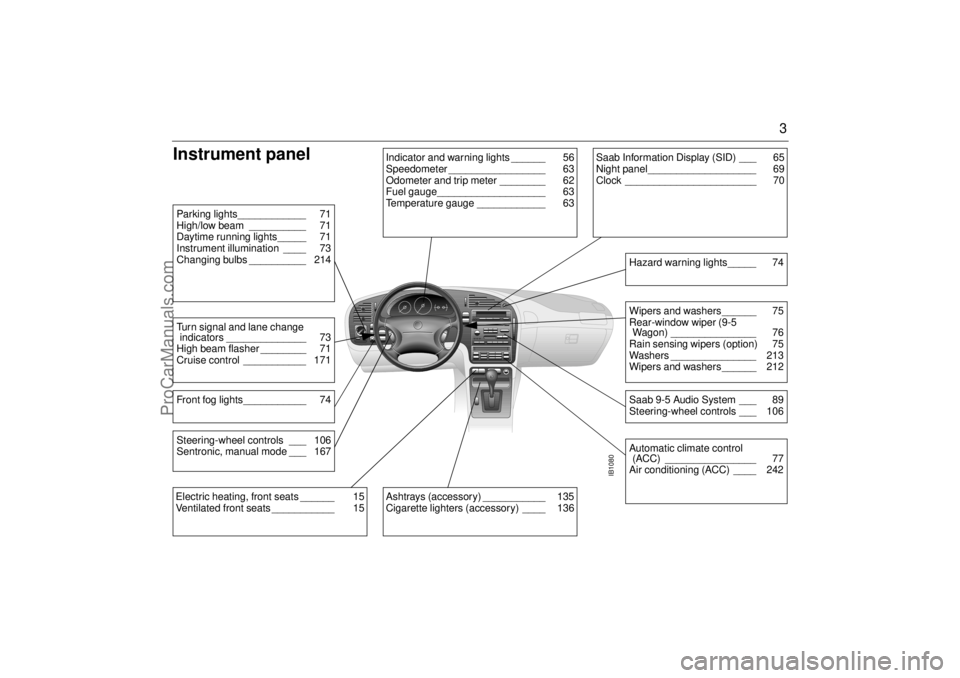
3
Instrument panel
IB1080
Indicator and warning lights ______ 56
Speedometer _________________ 63
Odometer and trip meter ________ 62
Fuel gauge___________________ 63
Temperature gauge ____________ 63
Parking lights____________ 71
High/low beam __________ 71
Daytime running lights_____ 71
Instrument illumination ____ 73
Changing bulbs __________ 214Turn signal and lane change
indicators ______________ 73
High beam flasher ________ 71
Cruise control ___________ 171Front fog lights___________ 74
Ashtrays (accessory) ___________ 135
Cigarette lighters (accessory) ____ 136
Saab Information Display (SID) ___ 65
Night panel___________________ 69
Clock _______________________ 70
Wipers and washers ______ 75
Rear-window wiper (9-5
Wagon) _______________ 76
Rain sensing wipers (option) 75
Washers _______________ 213
Wipers and washers ______ 212Saab 9-5 Audio System ___ 89
Steering-wheel controls ___ 106Hazard warning lights_____ 74Automatic climate control
(ACC) ________________ 77
Air conditioning (ACC) ____ 242
Electric heating, front seats ______ 15
Ventilated front seats ___________ 15Steering-wheel controls ___ 106
Sentronic, manual mode ___ 167
ProCarManuals.com
Page 5 of 288
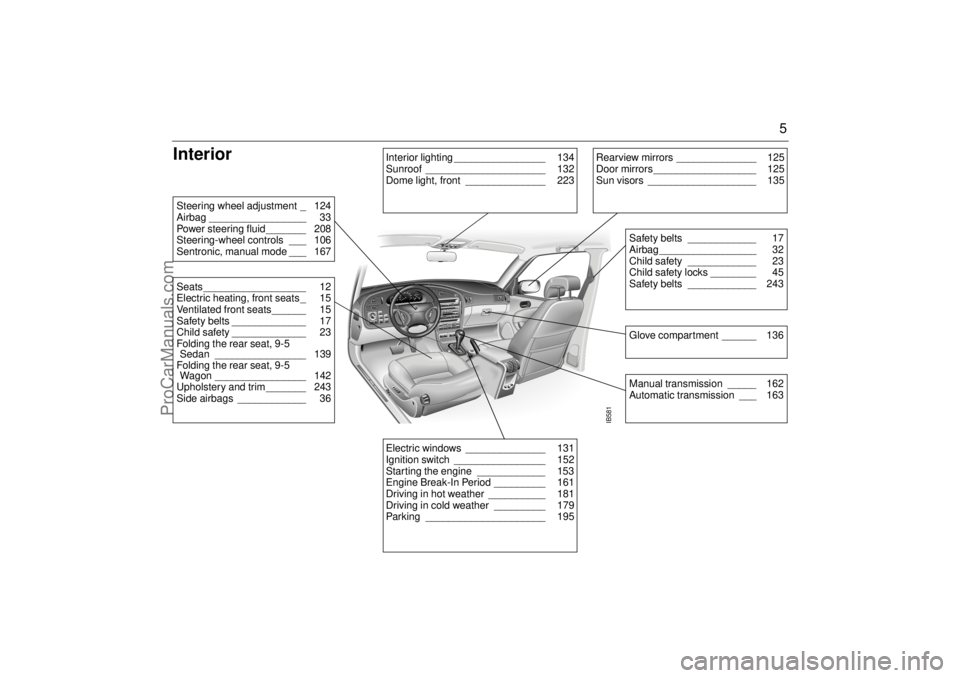
5
Interior
IB581
Rearview mirrors ______________ 125
Door mirrors __________________ 125
Sun visors ___________________ 135
Safety belts ____________ 17
Airbag _________________ 32
Child safety ____________ 23
Child safety locks ________ 45
Safety belts ____________ 243Glove compartment ______ 136Manual transmission _____ 162
Automatic transmission ___ 163
Electric windows ______________ 131
Ignition switch ________________ 152
Starting the engine ____________ 153
Engine Break-In Period _________ 161
Driving in hot weather __________ 181
Driving in cold weather _________ 179
Parking _____________________ 195
Steering wheel adjustment _ 124
Airbag _________________ 33
Power steering fluid _______ 208
Steering-wheel controls ___ 106
Sentronic, manual mode ___ 167Seats __________________ 12
Electric heating, front seats _ 15
Ventilated front seats______ 15
Safety belts _____________ 17
Child safety _____________ 23
Folding the rear seat, 9-5
Sedan ________________ 139
Folding the rear seat, 9-5
Wagon ________________ 142
Upholstery and trim _______ 243
Side airbags ____________ 36
Interior lighting ________________ 134
Sunroof _____________________ 132
Dome light, front ______________ 223
ProCarManuals.com
Page 6 of 288
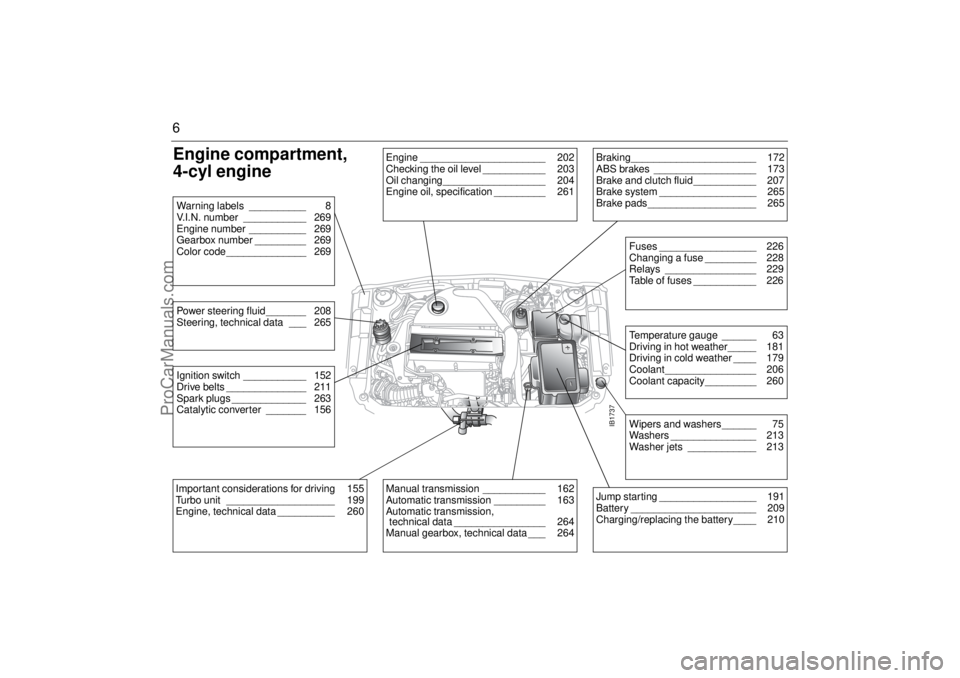
6Engine compartment,
4-cyl engine
IB1737
Engine ______________________ 202
Checking the oil level ___________ 203
Oil changing__________________ 204
Engine oil, specification _________ 261
Braking______________________ 172
ABS brakes __________________ 173
Brake and clutch fluid ___________ 207
Brake system _________________ 265
Brake pads ___________________ 265
Fuses _________________ 226
Changing a fuse _________ 228
Relays ________________ 229
Table of fuses ___________ 226Temperature gauge ______ 63
Driving in hot weather_____ 181
Driving in cold weather ____ 179
Coolant________________ 206
Coolant capacity_________ 260
Power steering fluid _______ 208
Steering, technical data ___ 265
Wipers and washers ______ 75
Washers _______________ 213
Washer jets ____________ 213
Jump starting _________________ 191
Battery ______________________ 209
Charging/replacing the battery____ 210
Manual transmission ___________ 162
Automatic transmission _________ 163
Automatic transmission,
technical data ________________ 264
Manual gearbox, technical data ___ 264
Important considerations for driving 155
Turbo unit ___________________ 199
Engine, technical data __________ 260Ignition switch ___________ 152
Drive belts ______________ 211
Spark plugs _____________ 263
Catalytic converter _______ 156Warning labels __________ 8
V.I.N. number ___________ 269
Engine number __________ 269
Gearbox number _________ 269
Color code______________ 269
ProCarManuals.com
Page 7 of 288
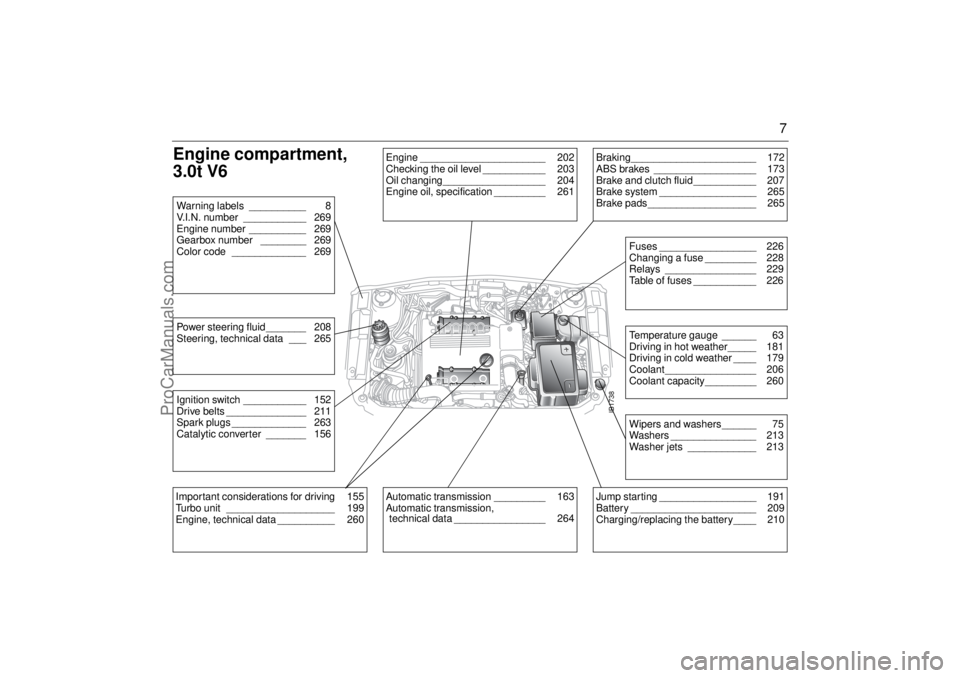
7
Engine compartment,
3.0t V6
IB1738
Warning labels __________ 8
V.I.N. number ___________ 269
Engine number __________ 269
Gearbox number ________ 269
Color code _____________ 269Ignition switch ___________ 152
Drive belts ______________ 211
Spark plugs _____________ 263
Catalytic converter _______ 156Important considerations for driving 155
Turbo unit ___________________ 199
Engine, technical data __________ 260
Automatic transmission _________ 163
Automatic transmission,
technical data ________________ 264
Braking______________________ 172
ABS brakes __________________ 173
Brake and clutch fluid ___________ 207
Brake system _________________ 265
Brake pads ___________________ 265Jump starting _________________ 191
Battery ______________________ 209
Charging/replacing the battery____ 210
Fuses _________________ 226
Changing a fuse _________ 228
Relays ________________ 229
Table of fuses ___________ 226Temperature gauge ______ 63
Driving in hot weather_____ 181
Driving in cold weather ____ 179
Coolant________________ 206
Coolant capacity_________ 260
Power steering fluid _______ 208
Steering, technical data ___ 265
Wipers and washers ______ 75
Washers _______________ 213
Washer jets ____________ 213
Engine ______________________ 202
Checking the oil level ___________ 203
Oil changing__________________ 204
Engine oil, specification _________ 261
ProCarManuals.com
Page 12 of 288
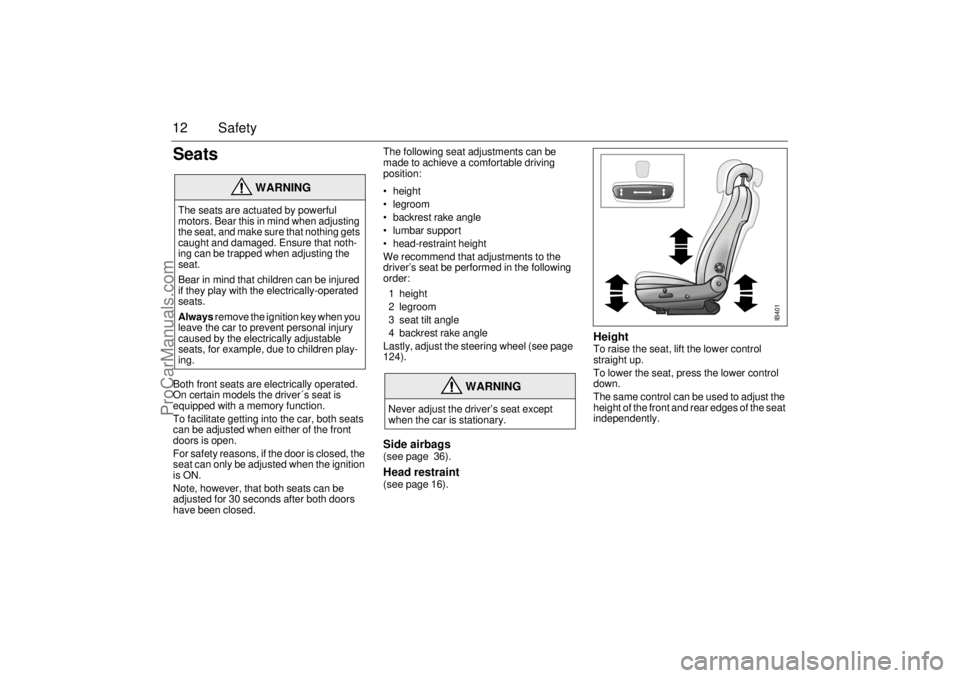
12 SafetySeats Both front seats are electrically operated.
On certain models the driver´s seat is
equipped with a memory function.
To facilitate getting into the car, both seats
can be adjusted when either of the front
doors is open.
For safety reasons, if the door is closed, the
seat can only be adjusted when the ignition
is ON.
Note, however, that both seats can be
adjusted for 30 seconds after both doors
have been closed. The following seat adjustments can be
made to achieve a comfortable driving
position:
height
legroom
backrest rake angle
lumbar support
head-restraint height
We recommend that adjustments to the
driver’s seat be performed in the following
order:
1height
2 legroom
3 seat tilt angle
4 backrest rake angle
Lastly, adjust the steering wheel (see page
124).
Side airbags (see page 36).Head restraint(see page 16).
Height To raise the seat, lift the lower control
straight up.
To lower the seat, press the lower control
down.
The same control can be used to adjust the
height of the front and rear edges of the seat
independently.
WARNING
The seats are actuated by powerful
motors. Bear this in mind when adjusting
the seat, and make sure that nothing gets
caught and damaged. Ensure that noth-
ing can be trapped when adjusting the
seat.
Bear in mind that children can be injured
if they play with the electrically-operated
seats.
Always remove the ignition key when you
leave the car to prevent personal injury
caused by the electrically adjustable
seats, for example, due to children play-
ing.
WARNING
Never adjust the driver’s seat except
when the car is stationary.
IB401
ProCarManuals.com
Page 33 of 288
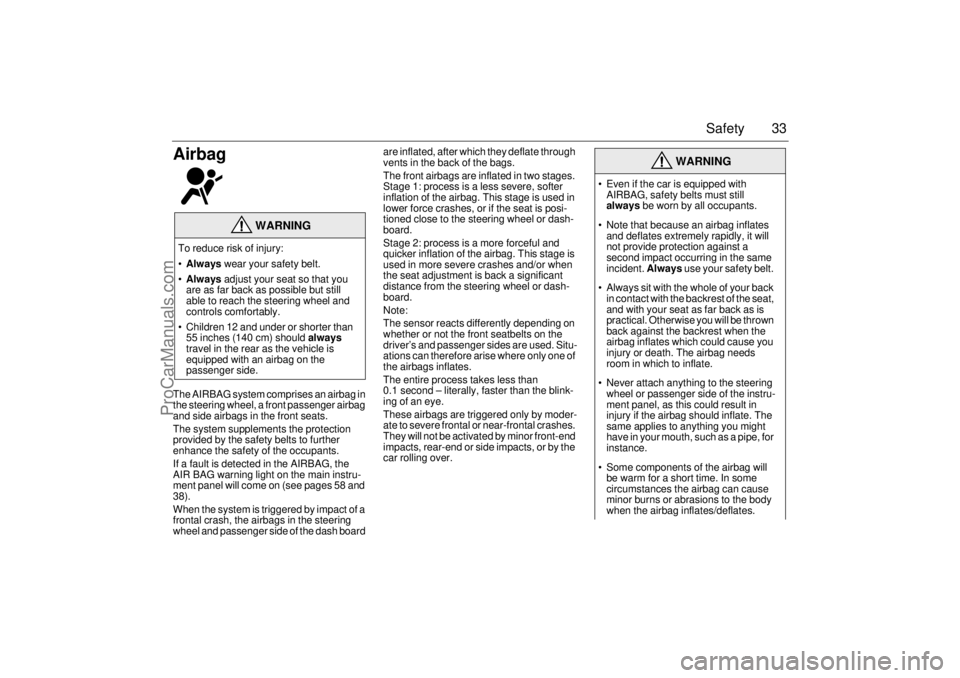
33 Safety
Airbag The AIRBAG system comprises an airbag in
the steering wheel, a front passenger airbag
and side airbags in the front seats.
The system supplements the protection
provided by the safety belts to further
enhance the safety of the occupants.
If a fault is detected in the AIRBAG, the
AIR BAG warning light on the main instru-
ment panel will come on (see pages 58 and
38).
When the system is triggered by impact of a
frontal crash, the airbags in the steering
wheel and passenger side of the dash board are inflated, after which they deflate through
vents in the back of the bags.
The front airbags are inflated in two stages.
Stage 1: process is a less severe, softer
inflation of the airbag. This stage is used in
lower force crashes, or if the seat is posi-
tioned close to the steering wheel or dash-
board.
Stage 2: process is a more forceful and
quicker inflation of the airbag. This stage is
used in more severe crashes and/or when
the seat adjustment is back a significant
distance from the steering wheel or dash-
board.
Note:
The sensor reacts differently depending on
whether or not the front seatbelts on the
driver’s and passenger sides are used. Situ-
ations can therefore arise where only one of
the airbags inflates.
The entire process takes less than
0.1 second – literally, faster than the blink-
ing of an eye.
These airbags are triggered only by moder-
ate to severe frontal or near-frontal crashes.
They will not be activated by minor front-end
impacts, rear-end or side impacts, or by the
car rolling over.
WARNING
To reduce risk of injury:
Always wear your safety belt.
Always adjust your seat so that you
are as far back as possible but still
able to reach the steering wheel and
controls comfortably.
Children 12 and under or shorter than
55 inches (140 cm) should always
travel in the rear as the vehicle is
equipped with an airbag on the
passenger side.
WARNING
Even if the car is equipped with
AIRBAG, safety belts must still
always be worn by all occupants.
Note that because an airbag inflates
and deflates extremely rapidly, it will
not provide protection against a
second impact occurring in the same
incident. Always use your safety belt.
Always sit with the whole of your back
in contact with the backrest of the seat,
and with your seat as far back as is
practical. Otherwise you will be thrown
back against the backrest when the
airbag inflates which could cause you
injury or death. The airbag needs
room in which to inflate.
Never attach anything to the steering
wheel or passenger side of the instru-
ment panel, as this could result in
injury if the airbag should inflate. The
same applies to anything you might
have in your mouth, such as a pipe, for
instance.
Some components of the airbag will
be warm for a short time. In some
circumstances the airbag can cause
minor burns or abrasions to the body
when the airbag inflates/deflates.
ProCarManuals.com
Page 34 of 288
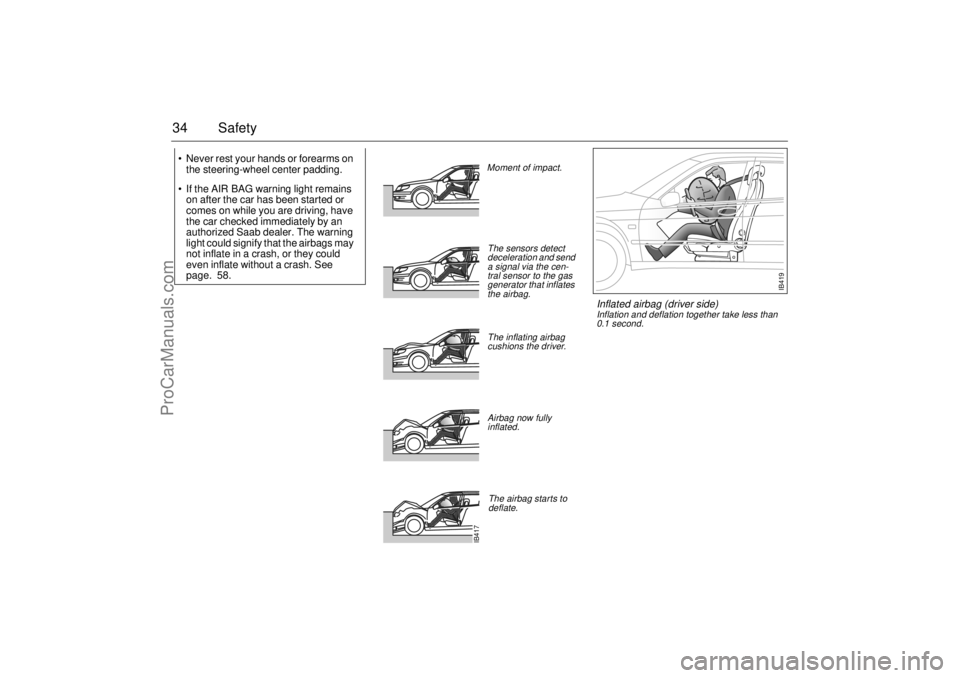
34 Safety Never rest your hands or forearms on
the steering-wheel center padding.
If the AIR BAG warning light remains
on after the car has been started or
comes on while you are driving, have
the car checked immediately by an
authorized Saab dealer. The warning
light could signify that the airbags may
not inflate in a crash, or they could
even inflate without a crash. See
page. 58.
IB417Moment of impact.
The sensors detect
deceleration and send
a signal via the cen-
tral sensor to the gas
generator that inflates
the airbag.
The inflating airbag
cushions the driver.
Airbag now fully
inflated.
The airbag starts to
deflate.
IB419
Inflated airbag (driver side) Inflation and deflation together take less than
0.1 second.
ProCarManuals.com
Page 35 of 288
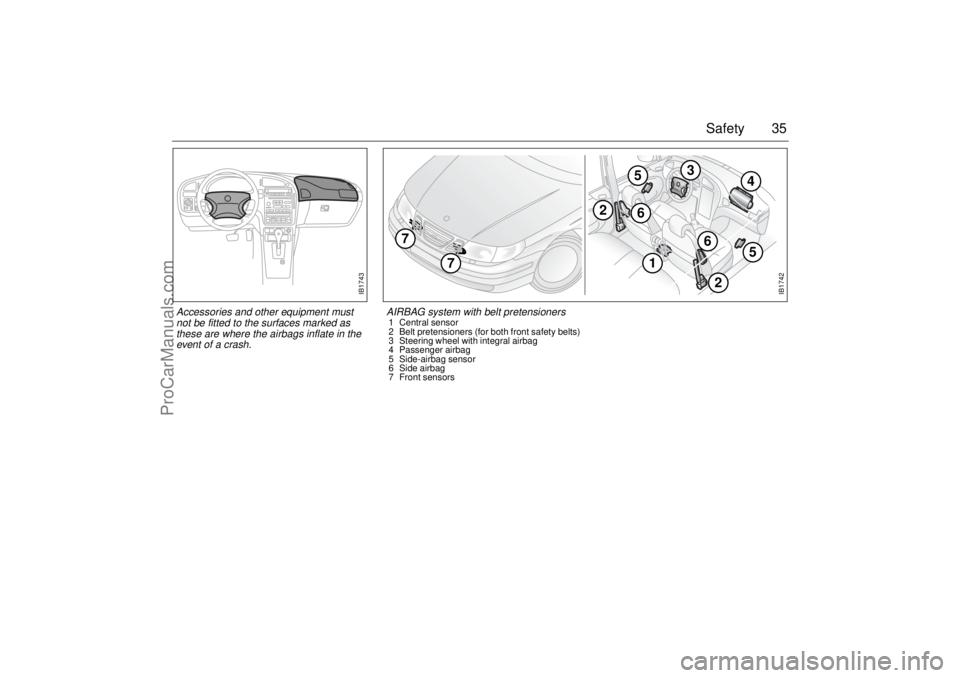
35 Safety
IB1742
5
1
4
2
6
3
2
6
7
7
5
AIRBAG system with belt pretensioners 1 Central sensor
2 Belt pretensioners (for both front safety belts)
3 Steering wheel with integral airbag
4 Passenger airbag
5 Side-airbag sensor
6 Side airbag
7 Front sensors
IB1743
Accessories and other equipment must
not be fitted to the surfaces marked as
these are where the airbags inflate in the
event of a crash.
ProCarManuals.com
Page 39 of 288

39 Safety
Scrapping or working on airbags
and belt pretensioners Frequently asked questions on func-
tion of airbags
Do you still need to wear a
safety b
elt if
airbags are fitted?
Yes, always! The airbag merely supple-
ments the car’s normal safety system.
Moreover, the airbag will only be actuated in
a moderate to severe frontal, or near-frontal
crash, which means, of course, that it
provides no protection in minor frontal
crashes, major rear-end or side-on crashes
or if the car rolls over.
The safety belts help reduce the chance of
the car occupants from being thrown around
and injured or killed inside the car.
But they also ensure that, if a crash occurs
in which the airbags are inflated, the airbag
will make the optimum contact with the
occupant, i.e. square on from the front. If the
occupant meets the airbag in an offset posi-
tion, the protection afforded will be reduced.
In addition, airbags provide no protection
against a secondary impact occurring in the
same incident. So there is no doubt about
the benefit of wearing safety belts at all
times.
Do not sit too close to the airbag: it needs
room to inflate.
The airbag inflates very quickly and power-
fully in order to protect an adult person,
before they are thrown forward, in a serious
frontal crash.
How do I position the seat to leave room for
the airbag to inflate?Don’t have your seat too far forward.
Recline the seat back to increase the
distance between you and the airbag. For
short drivers, special accessory pedal
extensions are available through your Saab
dealer.
Airbags inflate extremely rapidly and with
great force – to be fast enough to protect an
adult in the seat. When do the front airbags inflate? The airbag will only be inflated under certain
predetermined conditions in a moderate to
severe frontal, or near-frontal crash,
depending on such factors as the force and
angle of the impact, the speed of the car on
impact, and the resistance to deformation of
the impacting object.
The airbag can only be activated once in the
same incident.
Do not attempt to drive the car after an
airbag has been inflated, even if it is possi-
ble.
WARNING
Under no circumstances should any
modifications be made that affect the
steering wheel or the airbag’s electri-
cal circuitry.
Before starting any welding work on
the car, always disconnect the nega-
tive (–) battery lead and cover the
conductor.
Airbags and belt pretensioners must
be deployed under controlled condi-
tions before the car is scrapped or any
of the system’s components are
removed. Airbags or belt pretension-
ers that have been deployed as a
result of a crash must be replaced by
new ones.
Airbag-system components must
never be transferred for use in another
vehicle.
All work involving the scrapping or
replacement of airbags or belt preten-
sioners must only be carried out by
knowledgeable personnel.
ProCarManuals.com
Page 57 of 288
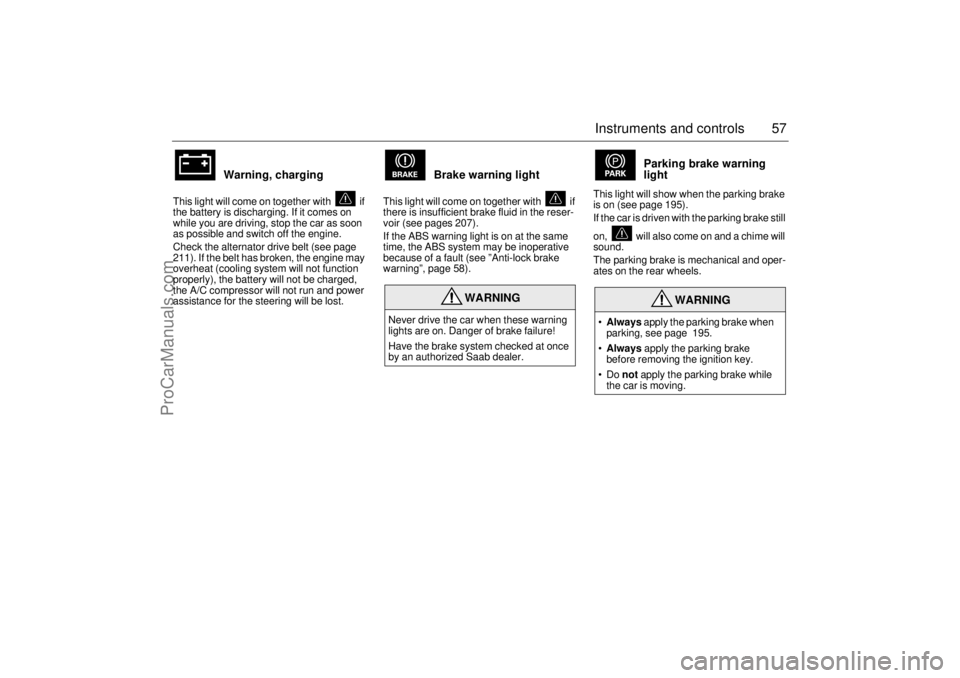
57 Instruments and controls
Warning, charging
This light will come on together with if
the battery is discharging. If it comes on
while you are driving, stop the car as soon
as possible and switch off the engine.
Check the alternator drive belt (see page
211). If the belt has broken, the engine may
overheat (cooling system will not function
properly), the battery will not be charged,
the A/C compressor will not run and power
assistance for the steering will be lost.
Brake warning light
This light will come on together with if
there is insufficient brake fluid in the reser-
voir (see pages 207).
If the ABS warning light is on at the same
time, the ABS system may be inoperative
because of a fault (see ”Anti-lock brake
warning”, page 58).
Parking brake warning
light
This light will show when the parking brake
is on (see page 195).
If the car is driven with the parking brake still
on, will also come on and a chime will
sound.
The parking brake is mechanical and oper-
ates on the rear wheels.
WARNING
Never drive the car when these warning
lights are on. Danger of brake failure!
Have the brake system checked at once
by an authorized Saab dealer.
WARNING
Always apply the parking brake when
parking, see page 195.
Always apply the parking brake
before removing the ignition key.
Do not apply the parking brake while
the car is moving.
ProCarManuals.com